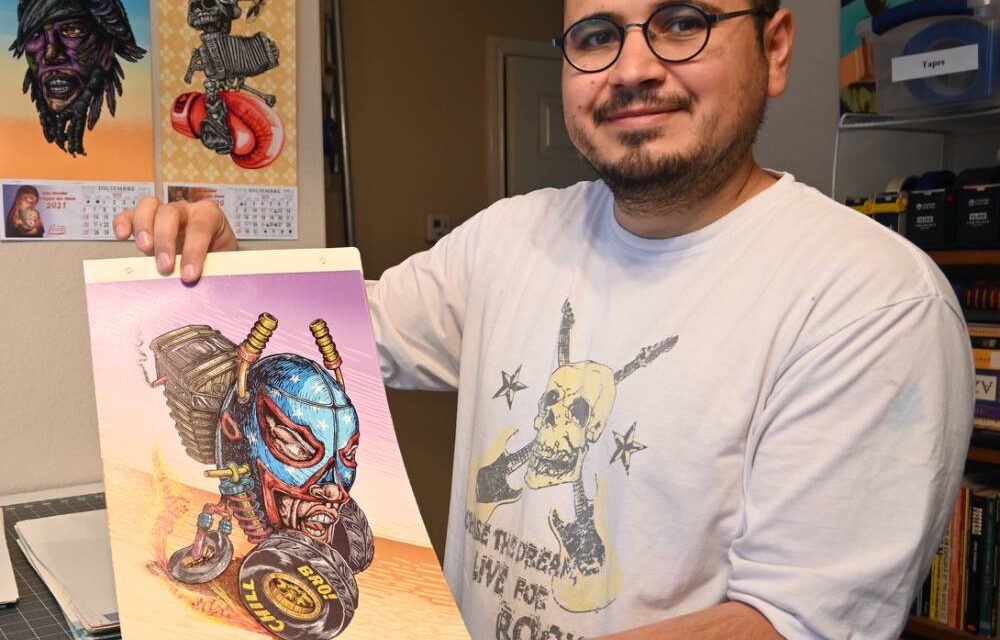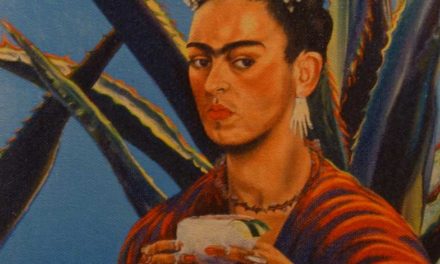The Contemporary at Blue Star features two borderland artists, Zeke Peña and Juan de Dios Mora, in an explosive new exhibit, In Passing: Fronteño Epics Across Time. Curator and Exhibition Manager Jacqueline Saragoza McGilvray wrote that Peña and Mora have “cultivated distinct, graphic styles to build worlds which expand time and space to address immigration and human rights, influenced by science fiction and satirical and cartooning traditions.” Both artists grew up in border communities of Texas and have a deep cultural, social, and political understanding of border life in that region.
Over the last quarter century El Paso and Laredo, the hometowns of these artists, have experienced a significant increase in migrants and political refugees arriving at the U.S.-Mexico border. To curtail migrants’ entry into the United States, both former President Donald Trump and Texas Governor Greg Abbott hyped their plans to build a 20-foot-high iron wall from Brownsville to Tijuana, a distance of more than 1200 miles. Like a modern great wall of China, the border wall was ill-advised, viewed by policy makers and construction engineers as a foolish, if not fiscally impractical idea. The
art works of Peña and Mora provide insights into the swirling and evolving border culture, militarization of security, and migration forces.
Border Report author Julian Resendiz disclosed the apprehension of 193,918 migrants in the El Paso sector alone in 2021. The majority of those arriving at the border are fleeing violence, corruption, or starvation. Although migrants come from dozens of countries, the majority are from Latin America, Central America, and Caribbean nations.
McGilvray, who curated the exhibit at The
Contemporary at Blue Star, placed the creative work of El Paso artist Zeke Peña front and center in the exhibit. She noted: “His work is a mash-up of political cartoon, border
rasquache, and Hip Hop culture that addresses universal themes of identity, politics, ecology, and social justice.”
Peña’s journey to becoming an artist and interpreter of border culture began during his teen years. As a high school student, Peña ventured into Juarez, Mexico for weekend soccer games and often joined his friends at social dances in Juarez. Peña studied art history at the University of Texas at Austin where he was inspired by the teaching of art history professor Amelia Malagamba.
Although he studied art history, Peña did not enroll in studio art classes.
Recognizing that he had not yet developed strong painting skills, Peña moved to San Antonio in 2013 to learn from Borderland artist Vincent Valdez. Peña took two classes with Valdez at the Southwest School of Art and over the period 2013-2016, he assisted Valdez in his
“Strangest Fruit” series. The additional training in art proved beneficial. Today, Peña describes himself as a painter, illustrator, and comic book artist. His art career received a boost in 2017 when he collaborated with author
Isabel Quintero to publish Photographic: The Life of Graciela Iturbide, a graphic art biography.
In his paintings, Peña strives to develop a narrative and connect with his audience with a well-developed story. Border residents from Brownsville to Tijuana experience the daily coming and going of border immigration agents and witness their constant surveillance of border crossing points. The exhibit at The Contemporary opens with a digital web comic titled “River Stories” showing hundreds of Peña’s narrative drawings of the border experience.
In one of his paintings, Peña shows border officers with large guns and exaggerated three foot binoculars with enlarged eyeballs peering out the front lens. Fences dominate the landscape. There is a dry river bed, a result of a drought caused by climate change. A figure representing death appears on the left side, a reminder that murder and execution are not uncommon on the border.
In 2020, the Smithsonian chose one of Peña’s works for inclusion in ¡Printing the Revolution! The Smithsonian book explores the rise of Chicano graphics within the early social movements of the 1960s and 1970s and “the ways in which Chicanx artists since then have advanced innovative printmaking practices attuned to social justice.”
At the Contemporary, the drawings of Juan de Dios Mora are placed opposite those of Peña. Glasstire Art critic Christina Rees, who viewed Mora’s work in a previous exhibit, noted that Mora “loads up his images with recognizable symbols of religion, mythology, pop and street culture, and signage, and these generously ground the viewer as we meet up with his travelers and feel the limits and potentials of their various trajectories.”
Juan de Dios Mora grew up in Acasico, a small ranch community with a population of 500 in Jalisco, Mexico. His family made a living growing maize and alfalfa. As a young boy, Mora would follow his father in the fields to irrigate rows of new crops. During Mora’s youth, his father also crossed the border into the United States to find seasonal work.
In 1998, Mora’s dad took advantage of President Ronald Reagan’s Amnesty plan and emigrated with his family to the United States, crossing the Texas border in Laredo. Mora wrote in his Artist Statement that in Laredo different cultures clashed and “yet expressions and emotions coalesced….However, here in the U.S., its traditions, racism, and stereotypes have introduced me to the reality of being an immigrant in a different country.”
concentrates on relief printmaking techniques to
create narratives of the Mexican and Mexican-American experience. He credits his experiences living along the
U.S.-Mexico border for providing an awareness of social and political concepts that heavily influence his artistic, aesthetic, and conceptual ideas. Themes reflected in his work include immigration, community life, culture, mythology, and family.
Christina Rees wrote eloquently in Glasstire Art magazine about Mora’s print series. Rees stated: “Mora’s deftness with this medium can’t be fully grasped in reproduction. The work is so nimble, textured, and detailed that it ripples across the page like water. Or cut glass. That Mora pairs this visual lusciousness with such trenchant subject matter is of course the thing that elevates the work from good to great.”
Many of Mora’s drawings show the movement of migrants crossing the Rio Grande River. In his new work, “Carrucha de Lugo” [Luxury Car], the artist places a migrant on a modified 1950s car being pulled by roosters and goats towards the U.S. banks of the Rio Grande River. The Mexican flag is visible behind him as is the American flag in front of his path. He carries a banner that reads “Wa Cha Te” [Chicano slang: “Watch Out”].
The editors of the Smithsonian Museum book, Printing The Revolution: The Rise and Impact of Chicano Graphics, 1965 to Now [2019], noted that Mora’s work “celebrates the texture of transnational immigrant life and ways in which rasquachismo–a Chicano making-do sensibility–extends to new generations of
Mexican-descent people in the United States.”
Mora is not content with simple expressions about the border and the immigrant experience. His art and his extraordinary skill in print-making excite art lovers in communities beyond the Borderlands. Mora, who holds two degrees from UTSA, recently began teaching printmaking in the UTSA art department as an Assistant Professor.
The Contemporary exhibit, In Passing: Fronteño Epics Across Time, challenges viewers to consider imaginative vistas of the border beyond the media narrative of fear and misinterpretations.










